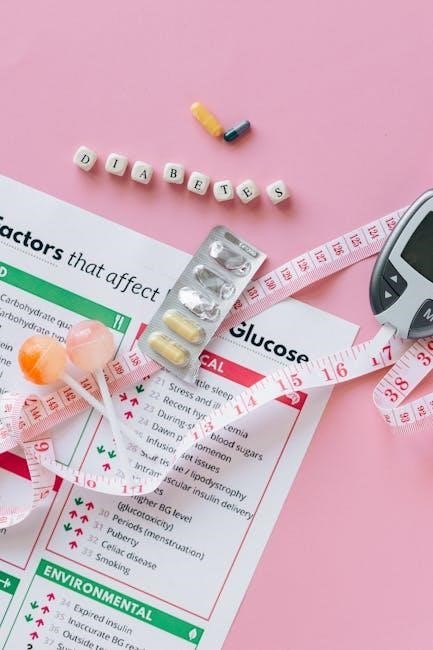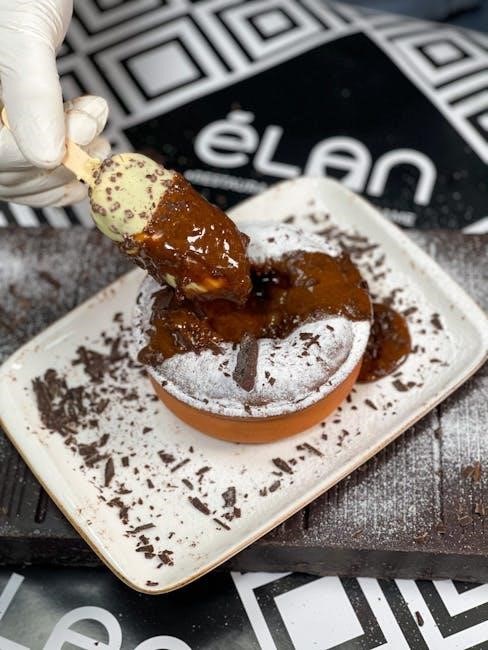
A sugar-free diet focuses on eliminating added sugars‚ promoting healthier choices․ A downloadable sugar-free food list PDF offers a comprehensive guide‚ helping you identify suitable foods‚ plan meals‚ and stay on track with expert tips for long-term success․
What is a Sugar-Free Diet?
A sugar-free diet involves eliminating added sugars from your diet‚ focusing on whole‚ nutrient-dense foods․ It emphasizes proteins‚ non-starchy vegetables‚ nuts‚ seeds‚ and healthy fats while avoiding sugary drinks‚ desserts‚ and processed foods․ The goal is to reduce sugar intake for better health outcomes‚ such as improved blood sugar control and weight management․ A sugar-free food list PDF serves as a guide‚ helping you identify approved foods and make informed choices․ This approach encourages mindful eating and reliance on natural food sources rather than refined or sweetened products‚ promoting a balanced and sustainable lifestyle․
Benefits of a Sugar-Free Diet
A sugar-free diet offers numerous health benefits‚ including improved blood sugar control‚ weight management‚ and reduced risk of chronic diseases․ It helps eliminate cravings‚ boosts energy levels‚ and enhances mental clarity․ By focusing on whole‚ nutrient-dense foods‚ this diet promotes better digestion and overall well-being․ Additionally‚ it encourages healthier eating habits and can lead to long-term lifestyle changes․ A sugar-free food list PDF provides a practical guide to making informed choices‚ ensuring you stay on track with your dietary goals․ This approach not only supports physical health but also fosters a more balanced and sustainable relationship with food․
Why a Sugar-Free Food List is Essential
A sugar-free food list is crucial for guiding your dietary choices‚ ensuring you avoid hidden sugars in everyday products․ It helps identify healthy alternatives‚ making grocery shopping and meal planning easier․ By referencing a sugar-free food list PDF‚ you can make informed decisions‚ avoiding accidental sugar intake․ This tool is especially valuable for those new to sugar-free diets‚ providing clarity on what to eat and what to avoid․ It also helps maintain consistency‚ reducing the risk of setbacks and keeping you on track toward your health goals․ A well-organized list simplifies the transition to a sugar-free lifestyle‚ offering a clear roadmap for success․
Understanding Sugar-Free Foods
Sugar-free foods exclude added sugars‚ focusing on natural sources․ A sugar-free food list PDF helps identify these options‚ guiding healthier choices and simplifying grocery shopping with organized categories․
Definition of Sugar-Free Foods
Sugar-free foods are products containing minimal to no added sugars‚ focusing on naturally occurring sugars found in whole foods․ These foods prioritize ingredients like vegetables‚ lean proteins‚ nuts‚ seeds‚ and healthy fats․ A sugar-free food list PDF helps identify such options‚ ensuring they meet dietary standards․ Examples include non-starchy vegetables‚ low-sugar fruits‚ and unprocessed meats․ These foods avoid refined sugars‚ artificial sweeteners‚ and hidden sugars often found in processed items․ By emphasizing whole‚ nutrient-dense ingredients‚ sugar-free foods support better blood sugar control and overall health․ This approach aligns with guidelines from experts‚ making it easier to adopt and maintain a balanced diet․
Common Sources of Hidden Sugars
Hidden sugars are often found in processed foods‚ sauces‚ dressings‚ and flavored beverages․ Even seemingly healthy options like yogurt‚ granola‚ and energy bars can contain high amounts of added sugars․ Condiments such as ketchup‚ BBQ sauce‚ and sweetened beverages are common culprits․ Additionally‚ sugar replacements and dairy alternatives may still contain sugars․ Always check labels to identify these sneaky sources․ A sugar-free food list PDF can help you avoid these hidden sugars by highlighting clean‚ unprocessed foods and providing guidance on making informed choices․ This resource is essential for maintaining a strict sugar-free diet and ensuring long-term success․
How to Identify Sugar-Free Foods
Identifying sugar-free foods requires careful label reading and understanding hidden sources of sugar․ A sugar-free food list PDF is an invaluable resource‚ providing a comprehensive guide to approved foods․ Look for products with no added sugars‚ focusing on whole foods like vegetables‚ meats‚ and nuts․ Be cautious of packaged items‚ as they often contain hidden sugars․ Opt for foods labeled “unsweetened” or “no added sugar․” Prioritize non-starchy vegetables‚ lean proteins‚ and healthy fats․ Downloadable guides can help streamline grocery shopping and meal planning‚ ensuring adherence to your sugar-free diet․ Always check ingredient lists and nutrition labels to confirm sugar content․
Proteins in a Sugar-Free Diet

High-quality proteins like meats‚ poultry‚ fish‚ and seafood are essential․ A sugar-free food list PDF guides you to select lean‚ nutrient-rich options‚ ensuring balanced nutrition without added sugars․
High-Quality Proteins to Include
High-quality proteins are essential for a sugar-free diet‚ providing sustained energy and supporting muscle health․ Include lean meats like chicken‚ turkey‚ and grass-fed beef‚ as well as fish and seafood rich in omega-3s‚ such as salmon and shrimp․ Eggs are another excellent option‚ offering versatile nutrition․ Dairy alternatives like Greek yogurt and cottage cheese are also great choices․ Opt for wild-caught and organic options when possible to avoid hidden sugars and additives․ These proteins help maintain satiety and balance blood sugar levels‚ making them a cornerstone of a successful sugar-free lifestyle․ Always check labels to ensure no added sugars are present․
Best Meats for a Sugar-Free Diet
When following a sugar-free diet‚ focus on selecting meats that are free from added sugars․ Opt for fresh‚ unprocessed options like poultry (chicken‚ turkey)‚ beef‚ pork‚ lamb‚ and game meats․ Avoid meats with marinades‚ sauces‚ or seasonings containing sugar․ Wild or grass-fed varieties are ideal‚ as they tend to have lower sugar content․ Processed meats like sausages or bacon should be chosen cautiously‚ ensuring they are sugar-free․ Always check labels or opt for homemade versions to control ingredients․ Incorporating these meats into your diet provides essential protein while aligning with your sugar-free goals․ A sugar-free food list PDF can help you make informed choices and stay consistent․
Fish and Seafood Options
Fish and seafood are excellent protein sources for a sugar-free diet․ Opt for fresh‚ wild-caught varieties like salmon‚ cod‚ and tilapia‚ which are naturally low in sugar․ Shellfish such as shrimp‚ mussels‚ and scallops are also great choices․ Avoid breaded or sauced options‚ as they often contain hidden sugars․ Grilling‚ baking‚ or steaming fish without sugary marinades keeps them sugar-free․ Incorporating fatty fish like salmon and sardines provides omega-3 fatty acids‚ supporting heart health․ A sugar-free food list PDF can help identify the best seafood options and ensure you stay within dietary guidelines while enjoying these nutritious proteins․
Eggs and Dairy Alternatives
Eggs are an excellent protein source and naturally sugar-free‚ making them a great addition to a sugar-free diet․ Dairy products like Greek yogurt and cottage cheese are also low in sugar‚ but opt for unflavored‚ unsweetened varieties․ For those avoiding dairy‚ plant-based alternatives such as almond milk and coconut milk are suitable‚ provided they are unsweetened․ These options provide essential nutrients and can enhance meal variety․ Always check labels to ensure no added sugars are present․ Incorporating these into your diet supports a balanced and sustainable sugar-free lifestyle while maintaining flavor and nutritional value․

Vegetables on a Sugar-Free Diet
Non-starchy vegetables like broccoli‚ spinach‚ and zucchini are ideal‚ as they are naturally low in sugar․ A sugar-free food list PDF can help you choose the best options and plan balanced meals․
Non-Starchy Vegetables to Prioritize
Non-starchy vegetables are a cornerstone of a sugar-free diet‚ offering low sugar content and high nutritional value․ Prioritize options like broccoli‚ spinach‚ kale‚ zucchini‚ and cucumbers‚ which are rich in fiber and essential vitamins․ These vegetables help regulate blood sugar levels and provide a feeling of fullness․ They are versatile and can be incorporated into meals in various forms‚ such as salads‚ stir-fries‚ or as snacks․ A sugar-free food list PDF often highlights these vegetables‚ making it easier to plan balanced meals․ By focusing on non-starchy varieties‚ you can enjoy flavorful and nutritious dishes while maintaining your dietary goals․
Low-Sugar Vegetable Options
Low-sugar vegetables are ideal for a sugar-free diet‚ offering essential nutrients without excessive natural sugars․ Options like carrots‚ sweet potatoes‚ green beans‚ cabbage‚ zucchini‚ pumpkin‚ asparagus‚ onion‚ celery‚ and cucumbers are excellent choices․ These vegetables are non-starchy and contain minimal fructose‚ making them suitable for maintaining blood sugar balance․ They are also rich in fiber‚ vitamins‚ and minerals‚ supporting overall health․ Incorporating these into meals provides variety and ensures you stay within sugar limits while enjoying flavorful and nutritious dishes․ Always refer to a sugar-free food list PDF for a detailed guide on portion sizes and preparation methods to maximize their benefits․
Vegetables to Limit or Avoid
While most vegetables are low in sugar‚ some starchy and high-sugar options should be limited or avoided․ Sweet potatoes‚ corn‚ and peas contain higher natural sugars․ Root vegetables like beets and carrots also have elevated sugar levels compared to leafy greens․ These can still be part of a sugar-free diet but should be consumed in moderation․ The sugar-free food list PDF often categorizes these vegetables as “caution” foods‚ recommending portion control to maintain dietary goals․ Balancing these with non-starchy vegetables and pairing them with proteins or healthy fats can help manage their impact on blood sugar levels․

Fruits on a Sugar-Free Diet
Focus on low-sugar fruits like berries‚ citrus‚ and apples․ Enjoy mindfully‚ as natural sugars can still impact your diet․ A sugar-free food list PDF provides guidance․
Low-Sugar Fruits to Enjoy
Low-sugar fruits are a great way to satisfy sweet cravings while adhering to a sugar-free diet․ Berries like strawberries‚ blueberries‚ and raspberries are excellent choices due to their naturally low sugar content․ Citrus fruits such as oranges and grapefruits are also ideal‚ offering a tangy flavor without excessive sugar․ Apples and pears are good options‚ but opt for smaller portions to keep sugar intake in check․ These fruits provide essential vitamins‚ antioxidants‚ and fiber‚ making them a nutritious addition to your meals; Always check the sugar content and portion sizes to ensure they align with your dietary goals․ Incorporating these fruits mindfully can enhance your sugar-free journey while keeping your taste buds satisfied․
Fruits to Limit or Avoid

While fruits are natural‚ some are high in sugar‚ making them unsuitable for a sugar-free diet․ Tropical fruits like mangoes‚ pineapples‚ and grapes contain high sugar levels․ Dried fruits‚ such as dates and raisins‚ are also concentrated in sugar․ Even seemingly healthy options like bananas and figs should be limited due to their natural sweetness․ Fruit juices‚ though natural‚ are similarly high in sugar and lack fiber‚ making them less ideal․ To maintain a sugar-free lifestyle‚ it’s best to opt for low-sugar fruits and consume them in moderation․ Always check the sugar content and portion sizes to stay aligned with your dietary goals․
How to Incorporate Fruits Mindfully
Incorporating fruits mindfully on a sugar-free diet involves choosing low-sugar options and practicing portion control․ Opt for fruits like berries‚ citrus‚ and apples‚ which naturally contain less sugar․ Pair fruits with nuts or yogurt to balance carbs and protein․ Be mindful of tropical fruits like mangoes and bananas‚ as they are higher in sugar․ Check labels or a sugar-free food list PDF to identify suitable choices․ Limit fruit juices‚ as they lack fiber and can spike blood sugar․ Instead‚ enjoy whole fruits to reap their nutritional benefits while maintaining sugar awareness․ This approach ensures you can still enjoy fruits without compromising your dietary goals․

Grains and Starches
Focus on low-sugar grain options like quinoa‚ oats‚ and almond flour․ Include starchy vegetables such as sweet potatoes and pumpkin‚ which are naturally low in sugar and rich in nutrients․
Low-Sugar Grain Options
When following a sugar-free diet‚ choosing the right grains is essential․ Opt for whole‚ unprocessed options like quinoa‚ brown rice‚ and oats‚ which are naturally low in sugar․ These grains are rich in fiber and nutrients‚ helping to regulate blood sugar levels․ Avoid refined grains like white bread and pasta‚ as they can spike sugar intake․ Look for products labeled as “100% whole grain” and check the ingredient list for added sugars․ Even whole grains should be consumed in moderation‚ as they still contain natural sugars․ Incorporating these low-sugar grain options into your diet can provide sustained energy without compromising your sugar-free goals․
Starchy Vegetables to Include
Starchy vegetables like sweet potatoes‚ carrots‚ and pumpkin are great additions to a sugar-free diet․ They provide fiber and nutrients while keeping sugar content low․ Opt for roasting or baking without added sugars to enhance flavor naturally․ These vegetables offer sustained energy and can replace high-sugar alternatives․ Portion control is key to maintaining blood sugar balance․ Incorporate them into meals for a nutritious‚ filling option that aligns with your sugar-free goals․ Always check a sugar-free food list PDF for portion guidelines and preparation tips to ensure you stay on track․
How to Choose the Right Grains
When selecting grains for a sugar-free diet‚ prioritize whole‚ unprocessed options like quinoa‚ brown rice‚ and oats․ Avoid refined grains‚ as they often contain hidden sugars․ Opt for products labeled “100% whole grain” or “unsweetened․” Always check the ingredient list for added sugars‚ which may appear as maltodextrin‚ dextrose‚ or sucrose․ Incorporate ancient grains like barley or rye for their lower glycemic index․ A sugar-free food list PDF can provide detailed guidance on grain choices‚ ensuring you make informed decisions․ Pair grains with protein or healthy fats to balance meals and maintain blood sugar stability․ This approach supports a well-structured‚ sugar-free dietary plan․

Nuts and Seeds
Nuts and seeds are excellent low-sugar options‚ providing healthy fats and nutrients; Choose almonds‚ walnuts‚ chia seeds‚ and flaxseeds․ Practice portion control to maintain calorie balance․
Healthy Nuts for a Sugar-Free Diet
Nuts are a great addition to a sugar-free diet‚ offering healthy fats and protein․ Almonds‚ walnuts‚ and pecans are excellent choices‚ rich in nutrients and low in natural sugars․ Opt for unsweetened and unsalted varieties to avoid hidden sugars․ Portion control is key‚ as nuts are calorie-dense․ A small handful (about 1 ounce) makes a satisfying snack․ When shopping‚ check labels to ensure no added sugars or artificial flavorings․ Incorporating nuts into meals or snacks provides sustained energy and supports overall health․ Refer to your sugar-free food list PDF for portion guidelines and additional nut options to keep your diet balanced and enjoyable․
Seeds to Include in Your Diet
Seeds are a great addition to a sugar-free diet‚ offering healthy fats‚ protein‚ and fiber․ Chia seeds‚ flaxseeds‚ and hemp seeds are excellent choices‚ as they are low in sugar and rich in nutrients․ Sunflower and pumpkin seeds also fit well‚ providing crunch and nutrition․ Many sugar-free food lists include seeds as a versatile option for snacks or adding texture to meals․ They support digestion and blood sugar control․ When choosing seeds‚ opt for unsweetened and unflavored varieties to avoid hidden sugars․ Incorporating seeds mindfully can enhance your diet’s nutritional profile while keeping it sugar-free․ Always refer to a reliable sugar-free food list PDF for guidance on portion sizes and best options․
Portion Control for Nuts and Seeds
Portion control is crucial when incorporating nuts and seeds into a sugar-free diet‚ as they are calorie-dense․ A sugar-free food list PDF often provides guidance on serving sizes‚ helping you avoid overconsumption․ Measure nuts and seeds using a food scale or measuring cups to stay accurate․ Aim for 1 ounce (about a handful) per serving․ Be mindful of added flavors or oils‚ which can introduce hidden sugars․ Pair nuts and seeds with vegetables or low-sugar fruits to balance your snacks․ Tracking portions ensures you reap their nutritional benefits without exceeding dietary goals․ This mindful approach supports sustainable weight management and overall health on a sugar-free diet․

Healthy Fats
Healthy fats‚ like avocados‚ nuts‚ seeds‚ and olive oil‚ are essential for a balanced diet․ Incorporate them into meals for sustained energy and flavor‚ enhancing your sugar-free lifestyle․
Best Sources of Healthy Fats
Healthy fats are essential for a balanced sugar-free diet‚ providing energy and supporting overall health; The best sources include avocados‚ nuts‚ seeds‚ and olive oil․ Avocados are rich in monounsaturated fats‚ while nuts like almonds and walnuts offer healthy polyunsaturated fats․ Seeds‚ such as chia and flax‚ are excellent for omega-3 fatty acids․ Olive oil is a great choice for cooking and dressings․ Fatty fish like salmon and mackerel are also recommended for their high omega-3 content․ Incorporating these fats into meals helps satisfy hunger and reduces cravings for sugary foods․ Always opt for unprocessed sources to avoid hidden sugars and ensure maximum nutritional benefits․
How to Incorporate Fats into Meals
Incorporating healthy fats into meals is essential for a balanced sugar-free diet․ Start by adding sources like avocados‚ nuts‚ seeds‚ or olive oil to dishes․ Use olive oil for cooking or as a dressing for salads․ Add nuts or seeds as toppings for yogurt or vegetables․ Avocados can be sliced into salads or used as a creamy base for sauces․ Fatty fish like salmon or mackerel are great for main meals․ Consider using coconut oil for baking or sautéing․ A sugar-free food list PDF can help identify approved fat sources․ Pair fats with proteins and vegetables for satisfying‚ nutrient-dense meals that keep you full and energized․
Understanding the Role of Fats

Fats are essential for a balanced diet‚ providing energy and aiding in the absorption of vitamins․ Healthy fats‚ like avocados‚ nuts‚ and olive oil‚ are crucial in a sugar-free diet as they reduce sugar cravings and promote satiety․ They also support brain health and hormone production․ Incorporating the right fats helps maintain flavor and satisfaction in meals‚ making it easier to stick to a sugar-free lifestyle․ Always choose high-quality‚ unprocessed sources to maximize benefits and avoid hidden sugars found in some processed fat-rich foods․ A sugar-free food list PDF can guide you in selecting the best fat options for your dietary needs․

Dairy and Alternatives
Opt for sugar-free dairy products like unsweetened yogurt and cheese․ Plant-based alternatives‚ such as almond milk‚ are great options․ Always check labels to ensure no added sugars are present․
Sugar-Free Dairy Products
When following a sugar-free diet‚ choosing the right dairy products is essential․ Opt for unsweetened‚ full-fat options like Greek yogurt‚ cottage cheese‚ and heavy cream․ These are naturally low in sugar and rich in nutrients․ Hard cheeses‚ such as cheddar or Parmesan‚ are also excellent choices․ Always check labels to ensure no added sugars are present․ Plant-based alternatives like unsweetened almond milk or coconut yogurt can be great substitutes for traditional dairy․ A sugar-free food list PDF often includes these items‚ making it easier to shop and plan meals․ Incorporating these dairy products helps maintain flavor and satisfaction while adhering to your dietary goals․
Plant-Based Dairy Alternatives
Plant-based dairy alternatives are ideal for a sugar-free diet‚ offering versatile options without refined sugars․ Unsweetened almond‚ coconut‚ oat‚ and cashew milk are popular choices‚ while yogurt alternatives like coconut or almond-based varieties provide creamy textures․ Many of these products are naturally low in sugar and can be found in a comprehensive sugar-free food list PDF․ When shopping‚ always check labels to ensure no added sugars․ Additionally‚ plant-based cheese alternatives made from nuts or soy can be included in moderation․ These options not only align with a sugar-free lifestyle but also cater to those with dietary restrictions‚ making meal planning easier and more enjoyable․
How to Choose the Right Dairy
Choosing the right dairy for a sugar-free diet involves focusing on sugar-free dairy products and plant-based alternatives․ Opt for unsweetened options like almond milk‚ Greek yogurt‚ or cottage cheese․ Always check labels to ensure no added sugars or artificial sweeteners․ Hard cheeses‚ such as cheddar or Parmesan‚ are naturally low in sugar․ For plant-based alternatives‚ select unsweetened versions of milk and yogurt․ A sugar-free food list PDF can provide detailed guidance on the best dairy choices․ Prioritize products with minimal ingredients and no hidden sugars to maintain a healthy‚ balanced diet while enjoying dairy responsibly․
Additional Resources
Download a free sugar-free food list PDF for a comprehensive guide to 100+ foods‚ meal planning tips‚ and expert advice to support your sugar-free journey effectively․
Downloadable Sugar-Free Food List PDF
A downloadable sugar-free food list PDF is an essential tool for anyone starting or maintaining a no-sugar diet․ This comprehensive guide provides a detailed list of 100+ sugar-free foods‚ organized by food categories such as proteins‚ vegetables‚ fruits‚ and grains․ It also includes meal planning tips and expert advice to help you make informed choices․ The PDF is designed to be user-friendly‚ making it easy to reference while grocery shopping or planning meals․ By downloading this resource‚ you’ll gain clarity on what to eat‚ avoid hidden sugars‚ and stay committed to your diet․ It’s a must-have for achieving long-term success on your sugar-free journey!
Meal Planning Tips for Sugar-Free Diets
Effective meal planning is crucial for maintaining a sugar-free diet․ Start by downloading a sugar-free food list PDF to guide your grocery shopping and daily meals․ Plan weekly menus in advance‚ focusing on whole‚ unprocessed foods like proteins‚ non-starchy vegetables‚ and healthy fats․ Incorporate variety by rotating ingredients and recipes to avoid monotony․ Use the food list to identify low-sugar options and ensure balanced nutrition․ Prep meals ahead to avoid last-minute‚ high-sugar choices․ Track your intake to stay accountable and adjust as needed․ With a well-structured plan‚ adhering to a sugar-free diet becomes manageable and sustainable for long-term health benefits․
Expert Advice for Maintaining a Sugar-Free Diet
Expert advice emphasizes the importance of gradual sugar reduction to avoid withdrawal symptoms․ A sugar-free food list PDF serves as a valuable resource‚ offering structured guidance․ Meal planning is crucial; track your intake to ensure compliance․ Focus on whole‚ unprocessed foods and mindful eating․ Stay hydrated and incorporate physical activity to curb cravings․ Seek support from communities or professionals to maintain motivation․ Regularly review and adjust your diet to avoid plateaus․ Remember‚ consistency is key to long-term success․ By following these tips‚ you can effectively manage a sugar-free lifestyle and achieve lasting health benefits․